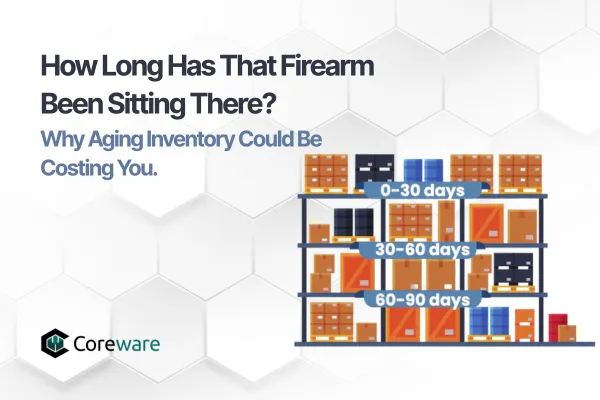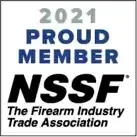coreILLA BLOG CORNER
Stay Informed with Digital Marketing Trends, Tips, and Success Stories

How Long Has That Firearm Been Sitting There? Why Aging Inventory Could Be Costing You
Running a retail gun store is a balancing act. Between managing compliance paperwork, keeping customers happy, training staff, and keeping up with market trends, there’s not a lot of time to sit back and assess what’s quietly gathering dust behind the counter.
But maybe it’s time to ask: How long has that firearm been sitting there?
Because if it’s been weeks—or worse, months—it might be costing you more than you think.
The Hidden Cost of Sitting Inventory
Every item on your shelf represents an investment. But when that investment just sits, it starts to drag down your store’s financial performance.
Let’s do the math.
Say you have 15 firearms that have each been in stock for 90 days, and each has an average cost of $500. That’s $7,500 tied up in aging inventory—capital that could be used to restock bestsellers, invest in marketing, improve merchandising, or even give your staff more resources.
And it’s not just about money. Aging inventory can also:
Lower your inventory turnover ratio (a key metric for retail health).
Skew your sales data and make future buying decisions harder.
Cause you to over-purchase, thinking your selection is thinner than it really is.
Diminish customer perception when they see the same inventory week after week.
In short, aging inventory is a silent killer of cash flow, especially for independent retailers where every dollar has to stretch.
Why This Happens (And How to Spot It)
In the firearms industry, it's easy to end up with stagnant inventory. Maybe you stocked up on a model that used to be popular, or a manufacturer released an updated version and demand shifted. Whatever the reason, the longer a firearm goes unsold, the more likely it is to lose value or demand.
The key to staying ahead of this is visibility—and that starts with having solid inventory data.
An Aged Inventory Report, specifically designed for firearms retailers, can help you see what’s been sitting too long and whether it’s worth keeping, discounting, or promoting.
Here are the fields you’ll want to focus on:
UPC: Lets you research competitive pricing and market demand.
Acquisition Date: Clearly shows how long the item has been on hand.
Cost and Price: Helps you calculate margins and make informed discounting decisions.
You don’t need fancy analytics tools—you just need clean, consistent data and a regular rhythm of checking it.
What You Can Do About It
Once you’ve identified the inventory that’s aging, the worst thing you can do is ignore it.
Instead, use it as an opportunity to re-engage customers, free up space, and breathe some life into your sales floor.
Here are five proven strategies to move aging firearms before they become a problem:
1. Reprice with Purpose
Try a tiered discount strategy based on how long the firearm has been in stock.
Example:
60 days in stock = 10% off
90 days = 15% off
120+ days = clearance pricing
This approach allows you to preserve margins for as long as possible while still incentivizing buyers.
2. Move It to a High-Visibility Area
Sometimes the issue isn’t price—it’s placement. If the firearm is tucked in a corner or buried behind newer inventory, customers may not even know it’s available.
Try creating a “Featured Firearm” spot near the entrance or checkout counter.
3. Give It a Story
Whether it’s online or in-store, give aging inventory a moment in the spotlight. Use signage or social posts to tell a story:
“This firearm has been in our store for 3 months. It’s reliable, accurate, and looking for a good home. This week only: take 10% off!”
Customers love authenticity—and framing it like a limited-time opportunity creates urgency.
4. Bundle It With Accessories
If the gun itself isn’t moving, pair it with something that adds value.
A free holster
Discounted optics
A range bag or cleaning kit
Bundles increase perceived value and give you an edge against other retailers selling the firearm alone.
5. Review and Adjust Buying Habits
After you've cleared out aging stock, take a step back and look at patterns.
Are certain calibers or manufacturers always slower to move?
Was there a seasonal spike that didn’t pan out?
Use this insight to inform future purchasing decisions. It’s okay to make bets—but great retailers learn from the ones that don’t pay off.
Let Data Drive Your Decisions
Here’s the thing: Every product you buy is a bet.
You’re betting that customers will want it, that it will sell quickly, and that it will bring in enough margin to justify its space on the shelf.
But every day a product sits, it’s losing value—and the longer you wait to address it, the harder it becomes to recover.
By routinely checking aged inventory reports and acting proactively, you can turn stale stock into fresh opportunities.
More importantly, you’ll create a culture of intentional inventory management—one where every decision is based on real numbers, not just gut feelings.
What the Industry Says
According to the National Retail Federation, excess inventory and poor inventory management cost U.S. retailers $50 billion annually. That figure might feel like a stretch for smaller stores, but the principle holds:
Inventory is either working for you—or against you.
Firearm retailers, in particular, deal with expensive, regulated inventory, where the margin for error is slim. Every decision counts, and smart inventory management is one of the best ways to stay profitable in a competitive market.
A Quick Checklist
Here’s a five-minute checklist you can run weekly to stay on top of aging inventory:
✅ Run your aged inventory report
✅ Filter for items in stock over 60 days
✅ Note cost, current price, and days on hand
✅ Choose one or two items to discount, relocate, or promote
✅ Rinse and repeat
Final Thoughts: Don’t Let Inventory Manage You
Inventory management doesn’t have to be overwhelming. With a little structure and the right insights, you can turn even your slowest-moving items into sales wins.
Because in retail, every square foot of shelf space should be working for you. And when it’s not? That’s your cue to take action.
P.S. Want Tools Built for Firearm Retail?
Coreware’s coreSTORE includes an Aged Firearm Report designed specifically for FFL retailers—giving you all the insights you need to keep inventory fresh and cash flow healthy.
Check it out corestore.com to learn how smarter tools can help you grow stronger, leaner, and more profitable.
Helping Small
Business Survive
and Thrive!
Coreware is a software provider offering affordable
and comprehensive solutions to help your business
grow.


Don’t be a stranger
Let us know if we can answer any questions.
For sales related inquiries, please drop us a line via email, call, or contact form.
We look forward to helping you grow your business with coreILLA!








